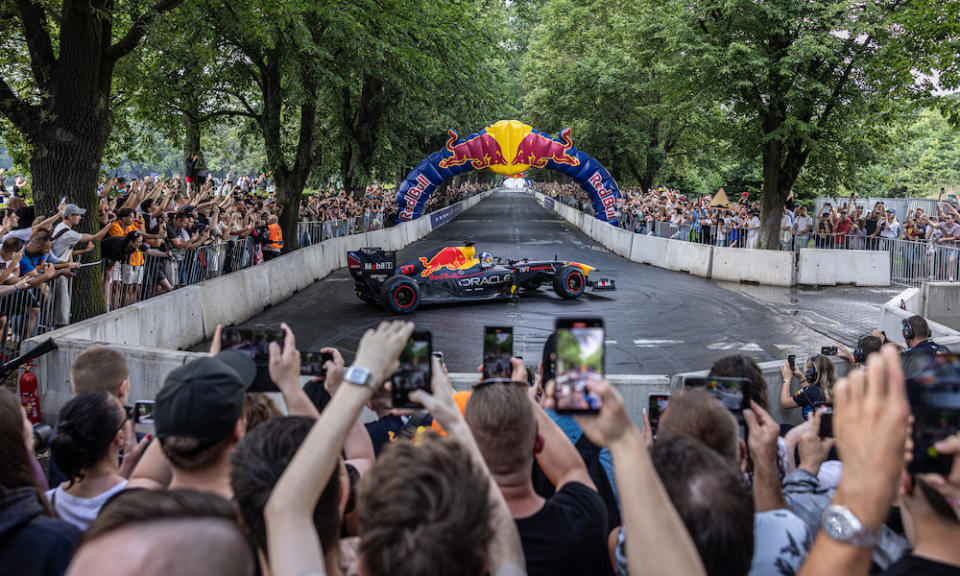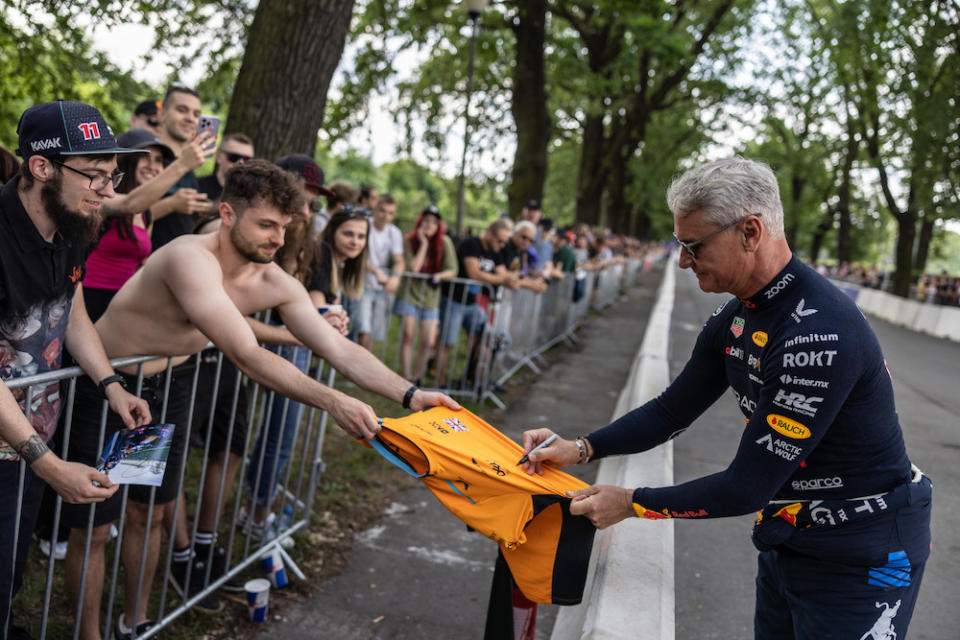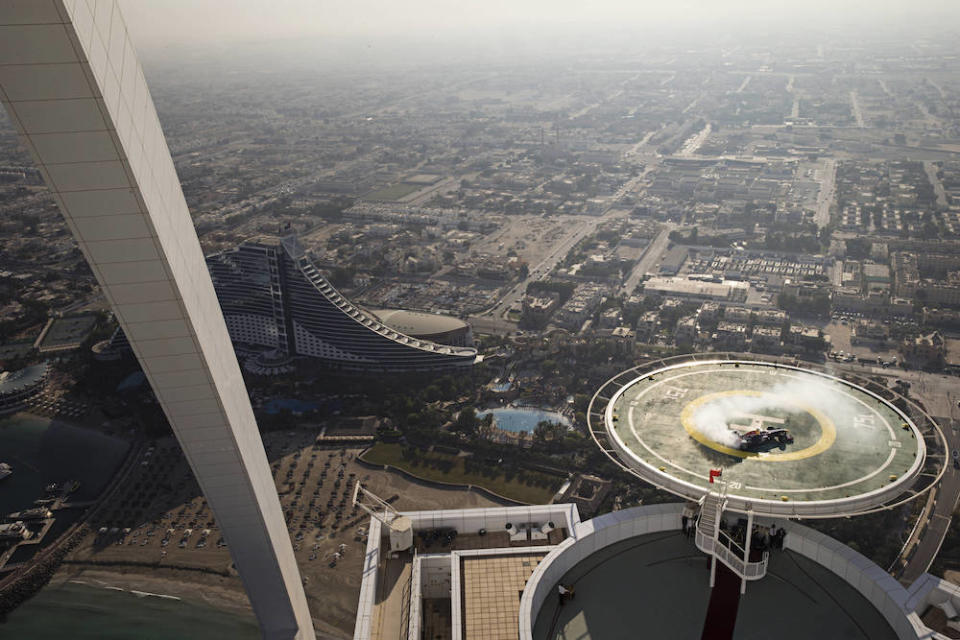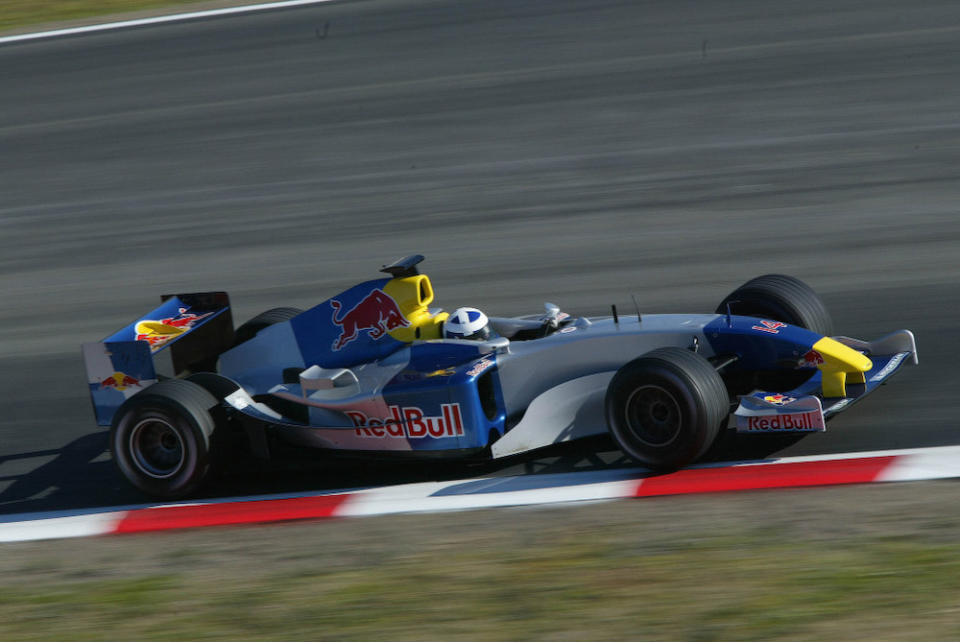How Coulthard kept his wings

When a Formula 1 driver retires, they might go and race elsewhere for a while. They might go into broadcasting, or move into the world of business. David Coulthard has done all of that since calling time on his F1 career at the end of 2008, but he’s also taken on the usual second career of being a Formula 1 driver. Again.
Ever since joining Red Bull Racing on day one of its existence in 2005, Coulthard has been the team’s go-to driver for its Showrun exploits. It’s a role that’s continued since he stopped competing in grands prix – in fact, he’s now been driving for the team in an extra-curricular capacity longer than he actually raced in F1.
“I wouldn’t be able to give an exact number, but it must be more than 50 over the years, including when I was in F1,” he tells RACER of the number of events he’s done outside of grands prix for Red Bull. “It’s always been an element, going and putting the car in the town.”
Coulthard and I are chatting at Wrocław’s Stadion Olimpijski in Poland where, after exploring the inner workings of Red Bull’s Showrun team last year, RACER’s been invited to experience what was learned on that day in the real world.
Red Bull is the only team doing these sorts of real-world, visceral events on a regular basis. In a world driven by the media and an F1 landscape dominated by the likes of Netflix and social media, they may seem unnecessary if all you’re after is exposure and brand awareness, but Coulthard says the first person experience is something that can’t be matched – even for the younger generation which might be more accustomed to a virtual or online world – and can be inspiring.
“We all want experiences,” he says. “I think what’s changed is that the younger generation are much better informed. They’re not better life experienced, but they’ve got much more knowledge and feelings as to what they are or what they want to be, and I think that we have to evolve and adapt to those situations.
“They can come and see a car. Okay, it’s different to a modern grand prix car, but it was still world class at its time and won many grands prix in the world championship.
“It’s a little experience and to see it, I think, helps you kind of size it. And if you’re a young designer or a young engineer, in your mind, you might, oh, that’s what I’d love to do. I find them inspirational.
“So anything where people can have the chance… there are kids here that are super-excited. A lot of them are really impressed. When they lift the body off, you’re seeing what was tech at that time, which you wouldn’t have had the opportunity to do back in the day for obvious reasons.”

Younger fans have endless ways to engage with F1 from behind a screen, but there Red Bull events are built around the premise that there’s no substitute for experiencing things first-hand. Damian Kramski/Red Bull Content Pool
The stadium element of the Wrocław event was an instant sell-out, necessitating an additional three runs on nearby streets to satisfy the five-figure crowd numbers, and Coulthard says such big numbers in obscure locations isn’t unusual.
“There’s no question that Red Bull have invested more time and energy in doing that, to the point where there’s a few of the places we’ve gone, and then very shortly afterwards, they’ve announced there’s going to be a grand prix there. I’m not sure that’s going to happen here, but I’m always amazed because it’s always so well received by the public on the ground,” he says. “There’s been ones where we’ve genuinely had tens of thousands of people turn up.”
It’s those more unusual assignments from Red Bull, along with the experience of sharing F1 with new audiences, that keeps Coulthard coming back for more.
“I have enjoyed the, let’s say, more challenging ones like being on top of the Burj Al Arab, because that is a once in a lifetime moment,” he recalls. “Now, I’m not saying that driving down Pennsylvania Avenue in Washington in a Formula 1 car isn’t a once in a lifetime moment, but I think it was just kind of so out there, and we did it as well in Miami (at the One Thousand Museum). They’re fun because at the end of the day you are doing something really quite different.
“But anywhere where you can actually sort of stretch your legs and show people what Formula 1 sounds like – the one in Dublin was a little bit wet last January, but it was just such a great atmosphere. The Irish don’t get very much Formula 1 action, so they were definitely up for it and the rain didn’t put them off, and we still were able to put on a reasonable show.”
So far there’s been nothing he’s said no to, describing himself as “pretty loose that way”. In fact, it’s the team that has held off from doing something Coulthard is keen to try: driving upside down.
“I want to do that, I’ve been actually lobbying the team for well over a decade, and they have done some research into it, and it’s just really been a question of timing and resources and all that sort of thing,” he says. “But I would like to be part of that because I trust the engineers, believe the science, and despite somebody once saying that, ‘Oh, we need a pilot for that’, I’m looking at and thinking, ‘I’m pretty sure we’re going to maintain contact with the ground.’ I would rather go with a driver than a pilot because if you lose contact, there’s no flaps, there’s no wings…”
The car he’s tasked with driving the most, the 2011 RB7, is rather different to the RB4 he raced in his final season, but he says it’s not something that feels a world away despite F1’s constantly-evolving nature, and that he’s managed to master certain tricks with it that even the best of the current race drivers don’t always manage.
“They’re V8s – it’s just a car, it’s a bigger car, it’s got a lot more tech going on, but at the end, the driver exploits what’s available to him,” he says. “I think anyone could jump in who’s driven a race car, I don’t think it particularly needs to be an F1 car.

David Coulthard experiencing a “once in a lifetime moment” on the helipad of the Burj Al Arab hotel in Dubai in 2013. Samo Vidic/Red Bull Content Pool
“The clutch is pretty jumpy sometimes, but I – touch wood – would say I’m actually, I think I’m reasonably good at donuts. Even Grand Prix drivers, they overspeed, and they end up doing sort of more like hot dogs, so I like to try and pride myself in leaving a nice circle at the end.”
He even adds that I wouldn’t have a hard time in the RB7 if I were to drive it.
“You can drive the car, absolutely, if you can drive,” he says. “(But) you might want to have a little spin around to get a feel for it first.”
While I did get some seat time in the car, it wasn’t fired up – because Red Bull takes playing around very seriously. And as the record books show, it’s every bit as serious at the race track, too. It’s a reflection of the brand that has been massively successful in everything it’s done, but not at the expense of keeping its teams and athletes bound to boring corporate rules of engagement.
“I remember asking Mr. (Red Bull co-founder Dietrich) Mateschitz right at the very beginning – because I’d been nine years at McLaren, and I fit it quite nicely into that environment – I said, ‘What is it I should know, what are the dos and don’ts?’ and he went, ‘Just be yourself’. That was as simple as that. If you fit with the brand, you’re with the brand. If you don’t want to be with the brand, then that’s fine. So it’s tremendously uncomplicated.
“It shouldn’t be for any of us to try and tell anyone else how to be,” he adds. “And I actually think that there’s no point having someone with their own personality and then saying ‘we’d like you to be like…’
“I need a briefing as to where I am and what I’m doing, but other than that, you’ve got to just say what you feel and believe and be professional. I don’t think that’s too much to ask.”
Coulthard arrived at Red Bull with almost a decade of experience at the multiple-championship-winning McLaren team and a few years before that at Williams, which he believes that helped him influence the once-floundering former Jaguar team and setting it on the path to become what it is today.
“I remember when I joined Red Bull, one of the things that I expressed to the team at that time was never to ask me whether I wanted to do something,” he says. “We’re part of a team. If it’s really important and you believe in it, tell me this is what you’re doing and I’ll do it, because if you’re asking, it puts a doubt in my mind.

The start of something big: Coulthard puts the brand-new Red Bull RB1 through its paces in F1 pre-season testing in Barcelona in 2005. Motorsport Images
“All people have to be aligned and go in the right direction, whether that’s the driver or whether it’s anyone else. So that, to me, is what a team is, and a team guides and leads their departments based on their knowledge and experience.”
Nowadays though, Coulthard has no influence on Red Bull’s F1 team, And when he’s not driving the squad’s old cars in strange places, he’s working as a TV analyst for Channel 4 in the UK. But don’t for a second think he’s getting tip-offs from his old team – he even sees that disconnect with the now-all-conquering outfit as very much a benefit.
“I’m not at all involved with the race team, I don’t have any special sort of knowledge or access to that, which is great for the role I do within television, because I can genuinely just say what I see,” says Coulthard, who is also a brand ambassador for Mercedes. “Despite some people always thinking that I’m kinder to one than the other, I think a lot of the time it’s their bias rather than my bias.
“I don’t decide who wins. I was genuinely excited at some of the grands prix when Mercedes were dominant, or even when Nico (Rosberg) was winning – who took me out of my last grand prix, not that I hold a grudge… well, I do hold a grudge, but credit where credit’s due, and if somebody’s done an incredible job and they’ve worked hard and delivered a great grand prix result, whoever that is, that’s what I feel as a fan of the sport I’m there to talk about. And I’ve got a little bit of insight, and I have an opinion.
“But you have your point of view, and someone else has their point of view, and you may get three different points of view, but in the end, that’s fine. I always found it fascinating that when it comes to incident, accidents and stewarding, I may see a certain way, but of course, the stewards may see another way, and I defer to the fact that they’ve got more information available to them in the same way that I had to when I was driving. I didn’t always agree with some of the penalties they gave me, but the referee is the referee.”
Coulthard’s retirement from racing coincided with an upturn in form for Red Bull. The year after he stepped aside, it won six races, and the year after that, it claimed its first two titles. I ask, despite his being more present in F1 than ever, if he regretted stepping away from racing in F1 a year or two too soon. Although it took away a near-certain chance to add to his haul of 13 grand prix victories, Coulthard insists it was the right time for him.
“I didn’t, because it’s all about energy and your lifespan in a certain role,” he explains. “And I think that there’s nothing worse than being the person that overstays their welcome. I think that I was in diminishing returns. I had great opportunities in my career to win races and battle somewhat for championships earlier in my career.
“I knew it was time, because when I tested the car at the beginning of 2008 for the first time, I knew it wasn’t going to be a grand prix winning car. That didn’t mean that we couldn’t win a grand prix, because there’s always those Olivier Panis in Monte Carlo moments [ED: with Ligier in 1996], but it was, in my opinion, highly unlikely, and that meant another 12 months of slog. And the way I raced, I didn’t just turn up and jump in the car. It was all-consuming, every day, every week, did all the testing, never missed events because it matters. It matters to show commitment.
“I think there’s been other more successful, lazier drivers – maybe that was the key to their success – but you’ve got to commit to what you believe is the right way to turn up and be part of a team. The reason why I was nine years at McLaren, and the reason why I still have a relationship with Red Bull today, is because of a work ethic and turning up when you’re supposed to do what you’re supposed to do and then try not to take anyone’s virtual wallet, which apparently, is a negative thing.”

 Yahoo Autos
Yahoo Autos 